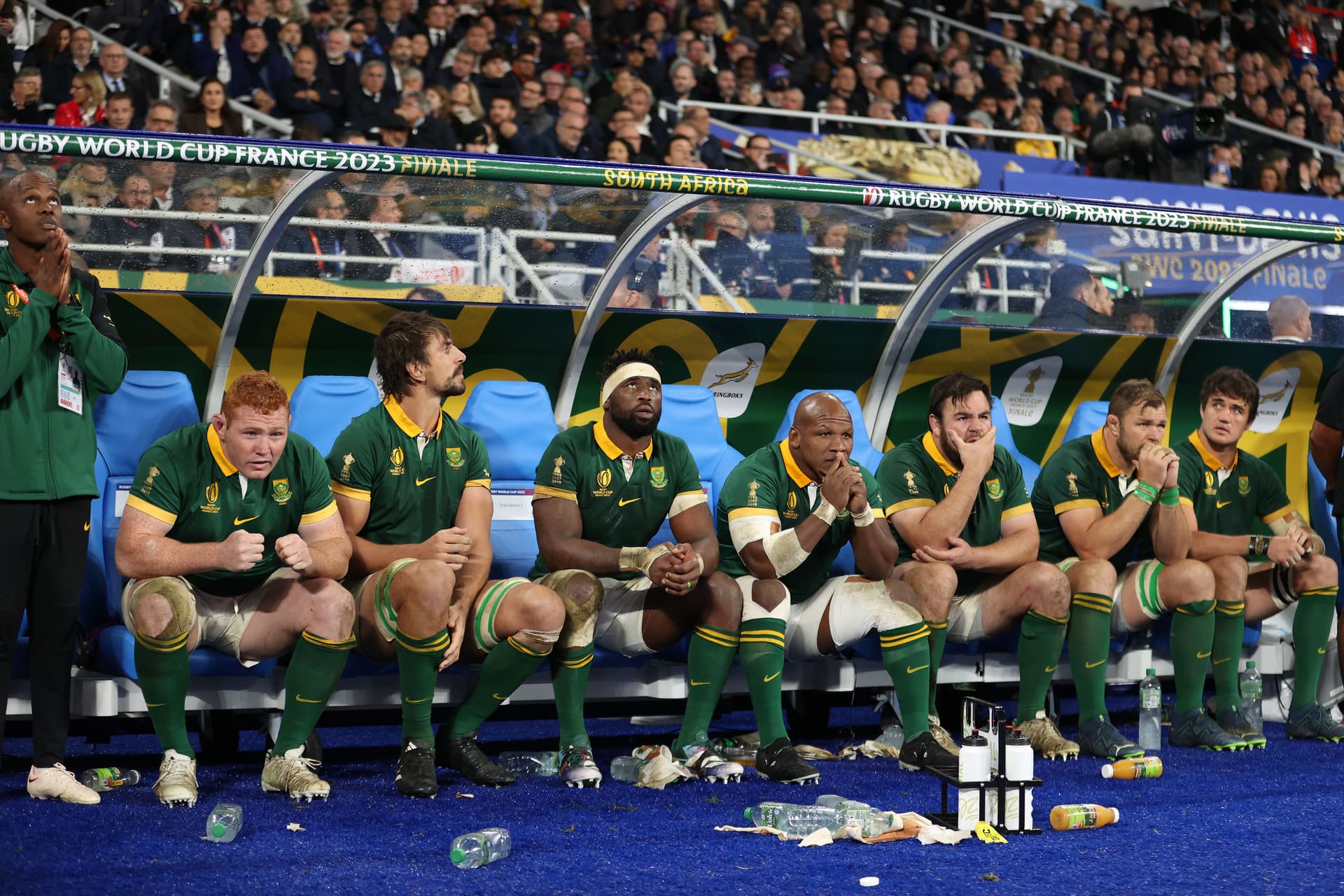Rugby
How Many Substitutes Are Allowed in Rugby Union?
There are eight substitutes on a rugby union team. They can be brought on the field at a stoppage in play either as a temporary injury or head injury assessment switch or a permanent tactical change.

New Zealand v South Africa: Final - Rugby World Cup France 2023//Getty Images
How Many Substitutes on a Rugby Union Team?
In rugby union, each team can name eight substitutes as per World Rugby rules. These players sit on the bench and are available to replace players in the starting XV. While rugby league teams only use four substitutes, rugby union allows a higher number.
The role of substitutes is essential in rugby union. They offer tactical flexibility and help manage player fatigue. Teams use substitutions strategically to maintain intensity, adapt to opposition tactics, and address injuries.
Typically, the eight substitutes cover different positions. The front row has three replacements – a hooker and two props. This is a safety requirement in case of injury to front-row players. Other substitutes cover the remaining forwards and backs.
However, not all substitutes necessarily play. Coaches can decide whether or not to bring a substitute onto the field, depending on the match situation. The rules allow for a maximum of eight substitutions, but a team might use fewer. If a game goes into extra time, such as in knockout tournaments, the same substitution rules apply.
| Sporting code | Starters | Substitutes allowed |
| Rugby union | 15 | 8 |
| Rugby Sevens | 7 | 5 |
| Rugby league | 13 | 4 |
In recent years, South Africa have occasionally gambled on a 7-1 split, although it is less common than the 6-2 split.
When Can Teams Make Substitutions In Rugby Union?
Substitutions in rugby union can occur for different reasons. There are three main categories: tactical, injury, and temporary substitutions.
Tactical Substitutions
Tactical substitutions happen when coaches want to change their approach. These can occur at any point during the game. Teams might introduce fresh legs in the final stages of a match to increase energy levels. Tactical substitutions are often used to bring on impact players who can change the game.

Ireland v New Zealand - Autumn Nations Series//Getty Images
Injury Substitutions
Injury substitutions occur when a player cannot continue due to injury. When this happens, a substitute is allowed to replace the injured player. In cases where the injury is serious, the replacement is permanent. This ensures player safety and maintains the team’s numbers on the field.
Temporary Substitutions
Temporary substitutions are permitted in certain cases. For instance, a player may leave the field for a head injury assessment (HIA). In this situation, a substitute can temporarily take their place. If the player passes the assessment, they can return to the field, and the substitute comes off. However, if they fail the HIA, the substitution becomes permanent.
The timing of substitutions is critical in rugby union. Coaches often use substitutions to manage the pace of the game, especially as players tire. A fresh player can make a significant impact, particularly in high-intensity matches. Substitutions can be made at any stoppage in play, provided the referee is notified.
What Is A Blood Bin Replacement?
The blood bin rule is unique to rugby union. It allows players to temporarily leave the field if they are bleeding. This rule is in place to maintain player safety and ensure hygiene standards on the field.
When a player has an open wound, they must go to the "blood bin." This gives them time to receive medical treatment, clean the wound, and stop the bleeding. A substitute temporarily replaces the player while they are off the field. This is called a "blood bin replacement."
The blood bin rule has specific time limits. A player must return to the field within 15 minutes. If the bleeding cannot be stopped within that period, the substitution becomes permanent. In this case, the player will not be allowed to return, and the replacement becomes an official substitute.
Blood bin replacements are used frequently in rugby union. Due to the physical nature of the sport, players often suffer cuts and abrasions. The rule helps keep the game flowing while ensuring that players receive proper medical attention.
What is a 6-2 Split?
A 6-2 split is a tactical substitution strategy in rugby union. This approach means a team names six forwards and only two backs among their eight substitutes. Typically, teams opt for a 5-3 split, where five forwards and three backs are on the bench. However, the 6-2 split has gained popularity, especially among teams with powerful forward packs, as it allows for greater physical presence and endurance in the forwards.
The 6-2 split strategy focuses on maximising strength and power in the forwards. By having more forwards on the bench, teams can rotate players who face high physical demands, such as props, locks, and back-rowers. This is particularly effective in the second half when fatigue starts to set in, allowing fresh forwards to maintain or even increase the intensity of scrums, line-outs, and tackles.
However, a 6-2 split comes with its risks. With only two backs on the bench, there is limited cover for injuries among backs. If a backline player is injured and the team lacks a suitable replacement, coaches may need to reshuffle players into unfamiliar positions, which can disrupt defensive and attacking formations.
The 6-2 split has been used by teams aiming to dominate physically and wear down opponents, especially in wet or muddy conditions that favour forward-heavy play. This tactic has been popularised by several top-tier teams, including the Springboks, who famously employed it in the 2019 Rugby World Cup to maximise their physical advantage.
Leonard Solms is a freelance journalist who has been covering local and international sport from South Africa since 2015. Best known for his work for ESPN, he has also written for Al Jazeera, The Continent, New Frame, Planet Rugby and GiveMeSport among several other publications.